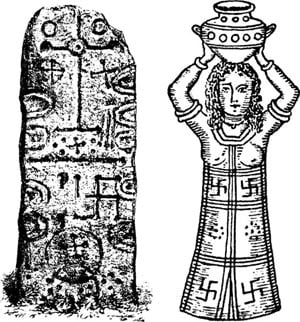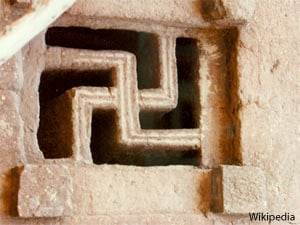 About Swastika
About Swastika
The symbol of the 4-sided swastika is an archetype for the rotations of time and consciousness – moving clockwise and counter clockwise – in upward or downward spirals – allowing souls to experience many levels of reality simultaneously.
Associated with – Sun, Brahma the creator god and luck, : Clockwise it represents the evolution of universe(Pravritti), anticlockwise it represents the involution of the universe(Nivritti).
It is also seen as pointing in all four directions and these signifies stability and groundedness.
The word Swastika comes from the most ancient language that is Sanskrit.
words su, meaning well, and asti, meaning to be.
The ubiquity of the swastika has been explained by three main theories: independent development, cultural diffusion and external event.

Swastika seems to have been used by early inhabitants of Eurasia. It is an important symbol in Eastern religions, notably Hinduism and Buddhism, among others, and was also used in Native American Faiths before World War ।।. By the early twentieth century it was regarded worldwide as a symbol of good luck and auspiciousness.
Since the rise of National Socialist German Workers Party, the swastika has been associated with fascism, racism, World War ।।, and the Holocaust in much of the western world. Before this, it was particularly well-recognized in Europe from the archaeological work of Heinrich Schliemann, who discovered the symbol in the site of ancient Troy and who associated it with the ancient migrations of Indo-European (Aryan) peoples.
Since the end of World War ।।, due to its association with Nazis, the traditional uses of the swastika in the western world were discouraged.
The swastika is common as a design motif in current Hindu architecture and India artwork as well as in ancient Western architecture, frequently appearing in mosaics, friezes and other works across the ancient world. In Chinese, Korean and Japanese art, the swastika is often found as part of a repeating pattern.
Today, the swastika symbol is prominent in Hinduism, which is considered the parent religion of Buddhism and Jainism, both borrowing the swastika from their parent.
In Hinduism right-facing swastikas are used. Whereas in Buddhism, because of association of right-facing swastika with Nazism, left-facing swastikas are used since the mid twentieth century.
Spreading along with Buddhism, today swastika is widely recognized in Southeast Asia, China, Korea, Japan, Tibet and Vietnam.
 On the walls of the Christian catacombs in Rome, the symbol of the Swastika appears next to the words “ZOTIKO ZOTIKO” which means “Life of Life”. It can also be found on the window openings of the mysterious Lalibela Rock churches of Ethiopia, and in various other churches around the world.
On the walls of the Christian catacombs in Rome, the symbol of the Swastika appears next to the words “ZOTIKO ZOTIKO” which means “Life of Life”. It can also be found on the window openings of the mysterious Lalibela Rock churches of Ethiopia, and in various other churches around the world.


 About Swastika
About Swastika